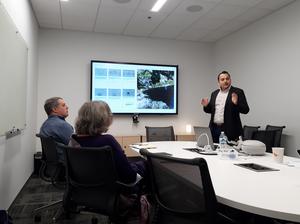
Our ability to see the world around us is not one that comes simply.
First, light passes through the cornea, the organ’s clear front layer. Then, some of this light enters through the pupil, while the iris — the colored part of the eye — controls how much light the pupil lets in. This light passes through the lens, a clear inner part of the eye; and the lens works with the cornea to focus light on the retina.
The retina is a light-sensitive layer of tissue at the back of the eye, and when light hits it, special cells, called photo receptors, turn it into electrical signals. These signals travel from the retina, through the optic nerve, and to the brain — which translates the signals into the vibrant, colorful images of the world we see.
It’s an intricate process, and one that long ago caught the attention of Monica Jablonski, who has spent the bulk of her career doing research on the eye.
“The eye is fascinating,” she told MBJ. “It’s a relatively small organ in the body, but it is so complex; and there’s so many specialized parts of the eye that all need to work together for a person to be able to see.”
Problems arise, however, when some of these parts begin to malfunction, or die off completely. And this is where her research comes in.
The two factors
Jablonski is a faculty member of the Hamilton Eye Institute at the University of Tennessee Health Science Center (UTHSC), and the founder and chief scientific officer of OculoTherapy, a UTHSC-connected startup.
Her company is developing a new therapeutic for glaucoma — the most common cause of irreversible blindness worldwide, she said — with an eye drop that could target both factors of the disease that lead to vision loss.
The first factor is intraocular pressure, the fluid pressure of the eye. People who have glaucoma can have elevated intraocular pressure; and if you can find a way to lower it, you can usually slow their loss of vision.
This is what many glaucoma treatments do, and Jablonski said theirs can lower the pressure “with great efficacy.”
But there’s a catch:
“Elevated interocular pressure is just a contributing factor,” Jablonski explained. “It’s not what’s actually causes the loss of vision.”
There are glaucoma patients whose pressure levels have been normalized, yet they’ve continued to lose their vision. There are also glaucoma patients whose pressure levels haven’t been heightened.
The primary cause of vision loss is, instead, the death of retinal ganglion cells, which are killed by glaucoma. Located in the retina, deep within the eye, retinal ganglion cells are pivotal to seeing. They transmit signals to your brain via their axons, which are long fibers that make up the previously mentioned optic nerve.
There are over a million retinal ganglion cells in the human retina, according to the Glaucoma Research Foundation, and once they die, they can’t be replaced.
But Jablonski believes her startup's treatment could protect retinal ganglion cells from death, in addition to lowering intraocular pressure; and she’s not the only one with confidence in the product. Her lab at UTHSC has scored a Resource-Related Research Projects (R24) grant worth $5.5 million from the National Institutes of Health (NIH) to help fund studies for the treatment. OculoTherapy has received two Small Business Innovation Research (SBIR) grants — one worth $365,000, and another worth $275,000.
These two latter grants have also received partial matching funds — worth $135,000 and $100,000, respectively — from entrepreneurial support organization LaunchTN.
And though Jablonski estimates the organization needs another $10 million to $15 million in funding to pay for the FDA-approval process, she estimates they could potentially earn approval in about three years.
But how exactly did Jablonski and her team discover this treatment? And where did it come from?
Repurposing Lyrica
A few years ago, as Jablonski looked for gene modulators and phenotypes associated with glaucoma, she made a discovery. There was a popular, FDA-approved drug that could help lower intraocular pressure — only it wasn’t used to treat the eye.
The drug was Pregabalin, otherwise known as Lyrica, Pfizer’s blockbuster medication that treats fibromyalgia and muscle pain. When Jablonski used eye drops containing the drug, intraocular pressure would go down.
And since the product has been around for a long time and is no longer patented, according to Jablonski, OculoTherapy can use it. She did reach out to Pfizer to ask about working together on the product, but she said the company wasn’t interested.
Her startup is instead moving forward on its own, and it’s repurposing the drug to make it more effective for eye usage. For example, when a solution is made with Pregabalin and put in the eye, lowering intraocular pressure, the effect doesn’t last very long.
So, OculoTherapy has developed a formulation that keeps the drug on the eye for a longer period, causing intraocular pressure to be lowered for longer. This extended length also allows more of the drug to enter the eye. And since more is entering the eye, it can diffuse to the retina — where the retina ganglion cells are located. The drug should then be able to protect the retinal ganglion cells from the death caused by glaucoma.
“Our hypothesis and prediction are that it would prevent the vision loss,” Jablonski said. “It wouldn’t bring dead retinal ganglion cells back to life, but if your cells haven’t died due to the disease, it would prevent them from dying.”
If Jablonski is right, then OculoTherapy’s treatment could bring significant relief to older populations, which are at a higher risk of developing glaucoma.
And this, she believes, is major.
“The sad thing is, eye diseases, like glaucoma … affect the elderly. They’re slowing down in their lives, they’re retired, and that’s the time when they can lose their vision,” she said. “It has a huge impact on their quality of life, because not only is their physical self not what it used to be, but then you can’t even see. You can’t see grandchildren’s faces. You can’t read, or needle point, or whatever it is you like to do with your time."









